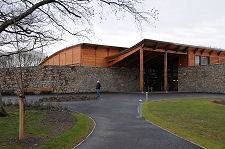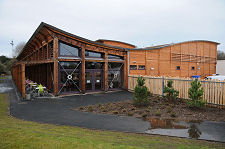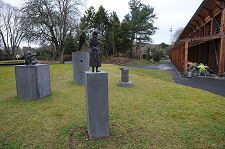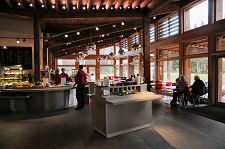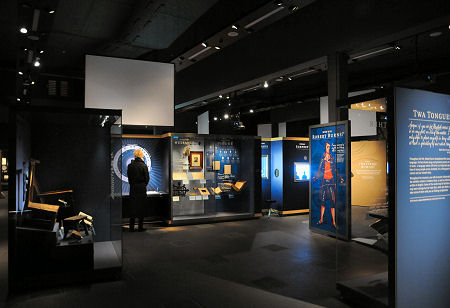 Inside the Museum |
Alloway's associations with Robert Burns began to attract visitors to what was then an isolated village on the road south from Ayr soon after the Bard's untimely death in 1796. Over the two centuries since, that initial flow of visitors has become a spate and Alloway is today, alongside Dumfries, one of the two absolutely essential stopping off points for any pilgrim on the trail of Robert Burns.
It would be fair to say that most of this period, the various Robert Burns visitor attractions in Alloway had a slightly scattered and unrelated feel. This all changed with the opening by the National Trust for Scotland of the magnificent Robert Burns Birthplace Museum at the end of 2010. As part of the process the NTS took over the custody of the other Robert Burns related attractions in the village. The result is, for the first time, that the visitor looking for the story of Robert Burns in Alloway is presented with a coherent set of attractions with, at its core, a truly worthy focal point in the form of the Birthplace Museum itself.
Also forming part of the museum is Burns Cottage, a few minutes walk away in the heart of Alloway along the Poet's Path; while at the same end of the village as the new museum are Auld Kirk Alloway, the Burns Monument and Memorial Garden, and the Brig o' Doon. On arrival at the museum or at Burns Cottage, both of which have parking, visitors are given a map which allows these elements to be linked together. Don't lose your map because the aim has clearly been to avoid overrunning the village with signposts. Each of these separate elements is the subject of a separate Undiscovered Scotland Feature Page.
The Robert Burns Birthplace Museum cost a total of £21 million to build, with funding coming from many sources including the Scottish Government. Visitors who only knew the obviously inadequate and now demolished "Tam o' Shanter Experience" which stood on an adjacent site previously, might think this a very large amount of money for a visitor centre. It is certainly a figure that leads you to approach the new museum with a degree of caution. The investment is so large that you hope against hope that it has been spent wisely and the resulting building is a worthy destination for visitors that does full justice to the man whose story it seeks to tell.
We were therefore greatly pleased to find that the museum is as good as we had hoped it would be, providing a truly world class destination for the worldwide fans of Robert Burns. The first thing that strikes you, even on the sort of driech day on which the exterior images on this page were taken, is that it is a very beautiful building. The rooflines and woodwork are spectacular, and both are superbly complemented by the massive curved stone walls that seem to funnel visitors into the main entrance.
Once inside, the true scale of the building becomes clear. This is a structure intended to cope with significant numbers of people without seeming crowded. The main central entrance hall and reception is also home to two shops and other visitor facilities. It leads through to the very large cafe which takes up the whole length of the rear of the building and which, on a nice day, can extend out into the garden beyond. It is worth noting that we found the prices of both food and drink in the cafe to be very reasonable indeed, and the quality of the food to be extremely high.
The real highlight of the new building is the large museum space given over to the life and works of Robert Burns. In the past the museum was housed in a pavilion built in 1900 adjacent to Burns Cottage, and while this had huge charm, the collection had outgrown the space available: and leaking roofs are not ideal companions to irreplacable manuscripts and first editions.
The design of the museum makes good use of modern display techniques and carefully directed lighting to lead you through every aspect of Burns' life and work. One of the real beauties is that you can approach the displays on many different levels and still thoroughly enjoy your visit. A casual visitor will gain a clearer understanding of who Robert Burns was and why he matters without being overwhelmed by detail: while a lifelong fan will find that detail is available if you care to look for it. Interactivity has a part to play, along with letters, paintings, artefacts and more, and the museum (and the rest of the building) is further brought to life by the use of quotes from Burns on walls, on windows, or hanging from ceilings.
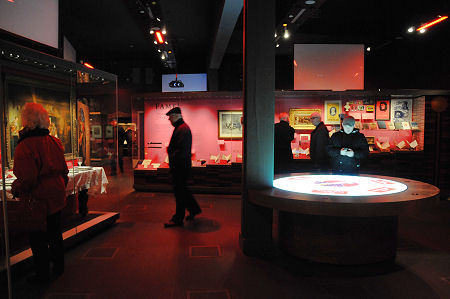 Another Part of the Museum |
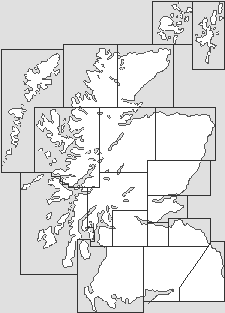
|
|
|
Visitor InformationView Location on MapAlloway, KA7 4PQ. Tel: 01292 443 700. burns@nts.org.uk Grid Ref: NS 335 186 www.burnsmuseum.org.uk Opening Hours Admission Accessibility |
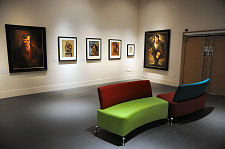 Burns Revealed by Howson |
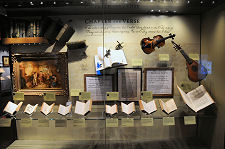 Chapter and Verse |
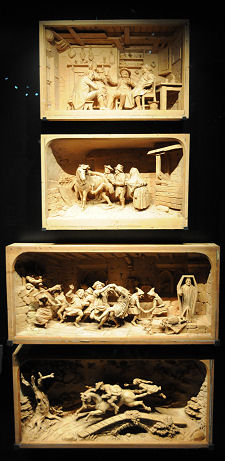 Woodcut Scenes from Tam o' Shanter |
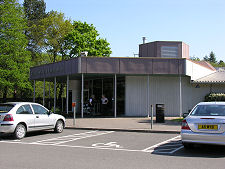 The Tam o' Shanter Experience (Now Demolished) |
